Definition: Consumer equilibrium is when the customer attains maximum satisfaction from his present consumption pattern with given income and prevailing market prices.
Here, the customer is not likely to change his expenditure and units consumed. This is because, he derives the highest utility from the commodities purchased with the given income.
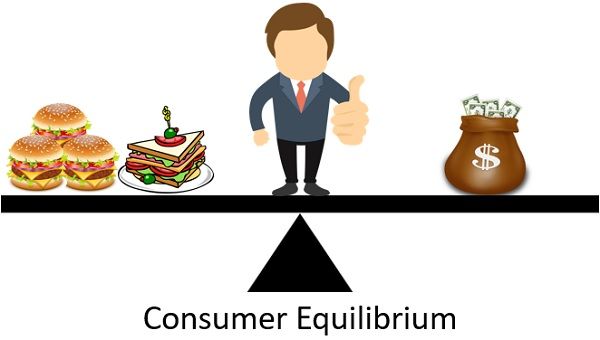
First, lets us understand what equilibrium is?
Equilibrium refers to a situation of balance. It is a point where one has no intentions to change the proportion between the two components.
In consumer equilibrium, the two components are:
- Customer’s Disposable Income
- Utility from Products
A rational customer aims at maximizing his satisfaction. He or She may spend his income on one or more commodities. The point of consumer equilibrium differs in both cases.
Content: Consumer Equilibrium
Consumer Equilibrium Conditions
Based on the measurability, we can explain the conditions of consumer equilibrium under two approaches:
- Cardinal Utility Approach- Utility Analysis
- Ordinal Utility Approach- Indifference Curve Analysis
Cardinal Utility Approach- Utility Analysis
This approach suggests that the utility derived from the products is cardinal, as given by Professor Alfred Marshall. In other words, utility is measurable in monetary terms and expressed numerically.
The quantity consumed affects the utility derived from that good.
Assumptions of Cardinal Utility Analysis:
- Fixed income of the consumer.
- Total revenue is spent on consumption.
- Utility from the product is in monetary terms.
- The price of the product is fixed and given.
Limitation of Utility Analysis
According to this approach, the utility is cardinal. But, it is a feeling, and one cannot express it in numbers.
Following are the two situations of Consumer Equilibrium based on cardinal utility analysis:
- Single Commodity case
- Two Commodities case
Consumer Equilibrium in case of Single Commodity
In this case, the consumer spends his total income on one commodity. The number of units consumed depends on two factors:-
1. Price paid per unit
2. Utility derived
The consumer will get maximum satisfaction where the price of the products equals the marginal utility from that product. This state of maximum satisfaction is the equilibrium point for the consumer.
The formula for calculating Consumers Equilibrium for a single commodity(X):-

Where,
MUX is the marginal utility of the product,
PX is the price of the product
Note: Marginal utility has to be in terms of money. We get this by dividing marginal utility in utils by marginal utility of money in one rupee.

Disequilibrium Conditions
- If the below condition satisfies, the customer will increase the consumption. But, due to the law of DMU, his satisfaction will reduce. He will stop consuming when he reaches equilibrium, i.e., MUX = PX

- If the below condition satisfies, the customer will reduce its consumption to increase the total satisfaction, as suggested by the law of DMU. To gain maximum satisfaction, he will try to reach equilibrium, i.e., MUX = PX.

Graphical Representation in Single Commodity Case
The following example shows the equilibrium condition of single commodity consumption.
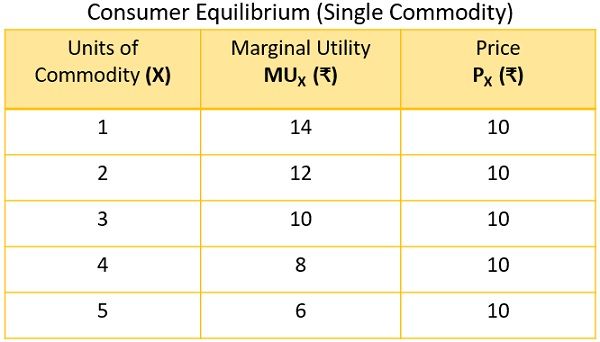
Suppose, the consumer is spending his income on purchasing product X. The price of X is Rupees 10/-. And the marginal utility in terms of money is shown in the table above.
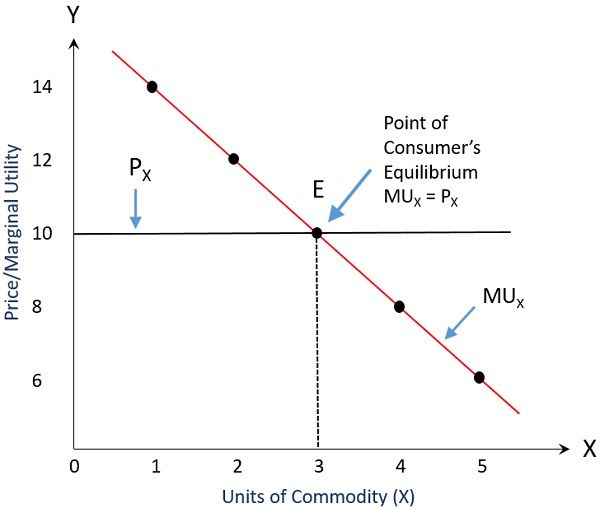
In the above graph:
- Units consumed by commodity X is placed on the X-axis.
- Price and Marginal utility are placed on the Y-axis.
- MUX intersects PX at point E.
- At point E, marginal utility MUX equals price-paid PX.
- The consumer will be at equilibrium at point E.
He will get maximum satisfaction on purchasing three units of the commodity X for Rs.10/-.
Consumer Equilibrium in case of Two Commodities
In this case, the customer decides to divide his total income by purchasing two or more products. He will get maximum satisfaction at a point at which he will reach an optimum quantity of these products in combination.
One must fulfil three conditions given below to reach consumers equilibrium:
- The marginal utility of money MUM is constant.
- With the consumption of more units of goods, the marginal utility falls.
- Fixed price of the product.
Let us assume these two commodities as X and Y. The following equation is a primary condition for consumer’s equilibrium:

Where,
MUX is the marginal utility of X
PX is the price paid for X
MUY is the marginal utility of Y
PY is the price paid for Y
Disequilibrium Conditions
1. If,
The customer increases his consumption on X then Y. However, his satisfaction will decrease. As a result, MUX will decline, and MUY will rise. He will continue to consume X until he reaches the primary equilibrium condition.
2. If,
In this, the consumer consumes more of commodity Y than X. His satisfaction will reduce because of the law of DMU. He will increase consumption on Y until he reaches the primary equilibrium condition.
Graphical Representation in Two Commodity Case
We will understand consumer equilibrium with two products in the following example.
Let us assume the two goods as Burger (B) and Sandwich (S).
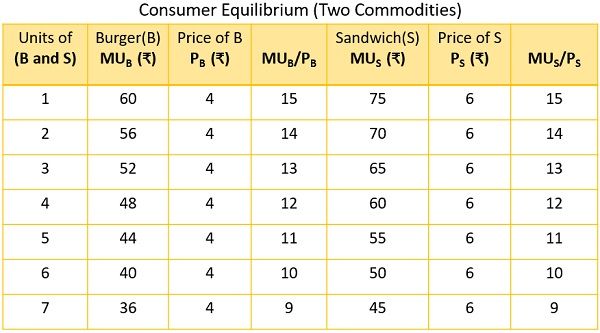
The price of B is Rs.4 per unit, and S is Rs.6 per unit. The income of the consumer is Rs.50/-. The marginal utility of money(MUM) is 11 per unit.
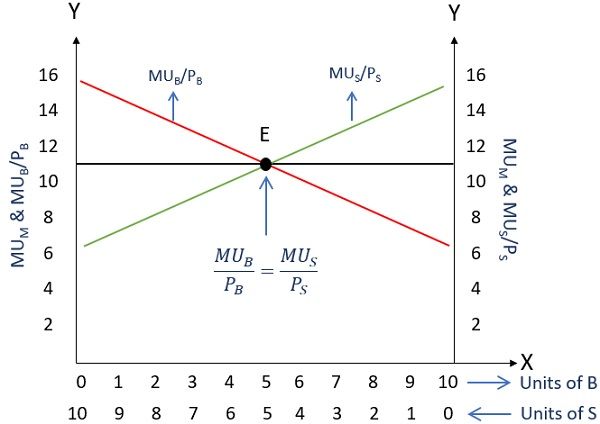
In the above graph,
- Units of Burger(B) and Sandwich(S) are plotted on the X-axis.
- The Marginal utility of B and S are placed on the Y-axis.
- Also, the marginal utility of money(MUM) is shown on the Y-Axis.
- E is the point of consumer equilibrium. Because at E, B and S are providing equi-marginal utility.
The consumer will be highly satisfied on consuming 5 units of Burger and Sandwich. This combination is the optimum quantity he can buy with the income of Rs.50/-.
Ordinal Utility Approach- Indifference Curve Analysis
This approach suggests that the utility cannot be cardinal. Instead, one can compare or rank it. Economists Hicks and Allen gave this theory.
The customer can state his preference for one product over another in various combinations. He can compare these combinations of the products called Bundles. And rank these bundles based on the satisfaction derived from them.
Now let’s discuss the consumer equilibrium through the indifference curve based on the ordinal utility.
Consumer Equilibrium under Indifference Curve
An indifference curve shows various alternatives of the two products in combination. These combinations avail the same utility throughout the curve.
The customer will get the highest satisfaction on attaining the most preferred combination of the two products. Because of the fixed income of the customer, the equilibrium point must fall on the budget line.
Consumers equilibrium will be a point where the budget line touches the highest indifference curve.
Assumption of Indifference Curve analysis
- The customer is rational and aims to maximize his profits.
- The goods are homogeneous and divisible.
- The customer’s income is constant and spent on purchasing two goods.
- No changes in the customer’s taste or preferences.
- The market of two goods is in perfect competition.
- Utility derived from the commodities can only be ranked.
- Customers preferences are depicted through an indifference map. These preferences remain unchanged during the analysis.
Let the two commodities be X and Y.
Equilibrium Conditions
A budget line must be tangent to the indifference curve.

Where,
MRSXY is the marginal rate of substitution of commodities X and Y.
PX is the X’s market price.
PY is the Y’s market price.
An indifference curve should be convex to the origin. The MRS of the commodity for X in terms of Y should be negative.
Disequilibrium Conditions
1. If,
The consumer gives up more Y units to acquire one X unit than the market allows. It will increase consumption of good X and a fall in MRS. He will consume more of X until MRS becomes equal to the price ratio of X and Y.
2. If,
The consumer gives up fewer Y units to acquire one X unit than the market requires. It will reduce consumption of good X and a rise in MRS. He will consume less of X until MRS becomes equal to the price ratio of X and Y.
Graphical representation of Indifference Curve Analysis
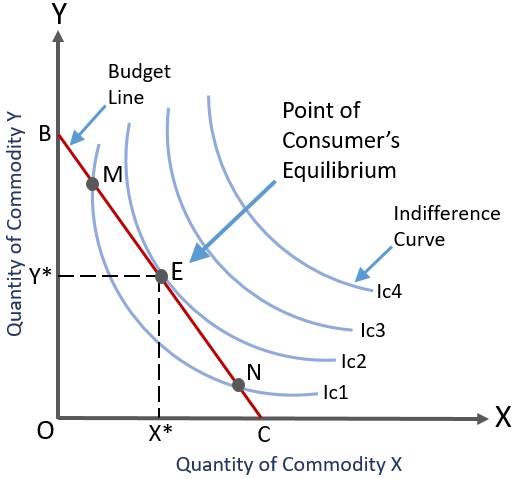
In the above graph:
- Units of X is plotted on the X-axis. And units of commodity Y is plotted on Y-axis.
- BC depicts the budget line. Whereas Ic1,2,3 & 4 shows the indifference curves.
- At E, the budget line touches the Ic2.
- At M and N also the budget line touches Ic1.
- The consumer will be at equilibrium at point E.
As stated above, the customer gets maximum satisfaction at the highest indifference curve.
If he moves backwards in BC towards M or forwards towards N. It will give him less satisfaction as they lie on the lower indifference curve.
Thus, Y*and X* quantity of goods will be the optimum combination of goods. This bundle will provide maximum satisfaction to the consumer.
Final Words
To sum up, the ultimate aim of the consumer is to get maximum satisfaction on commodity consumption. This satisfaction is the utility or benefit derived from the product after consumption.
The consumer will be in a state of no change when he procures maximum satisfaction. He will only get less satisfaction below or above this state.
Leave a Reply